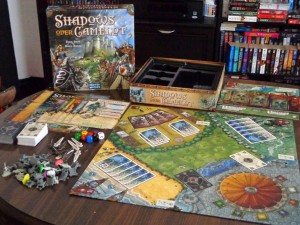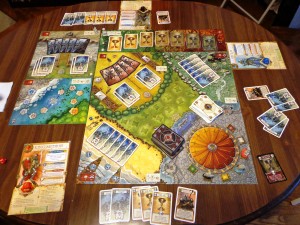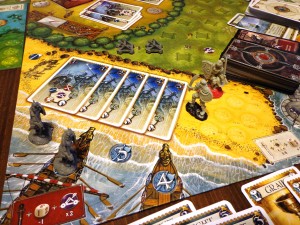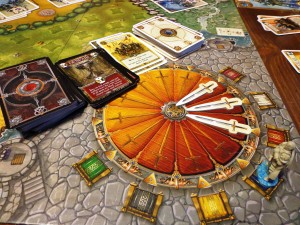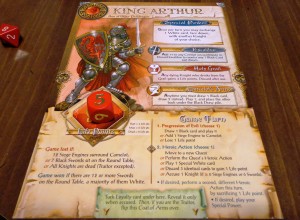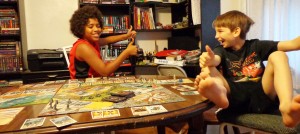Ah…Camelot. How I respect thee. I’m not sure why, but I’ve always been a fan of knights, archers, catapults, and everything else related to stories involving King Arthur, the Round Table, and anything else medieval themed. Perhaps it is because these stories revolve around simpler times, or maybe because some of them involve magic. Whatever the case, the combination of “Camelot” and “Days of Wonder” on the box helped me to take the plunge…though I was unprepared by just how different this game turned out to be compared to everything else in my collection.
Shadows over Camelot is a cooperative game in which players will be working together to ensure that good triumphs over evil. Similar to Flash Point, Castle Panic, and Pandemic, players will be performing actions for the board in the name of evil, whether they want to or not. Players will be completing various quests to try and earn white swords…earn enough of them, and the players win the game. Like Battlestar Galactica, there is a chance that one of the players may be secretly working against the others. Not only will players be trying to complete quests, but they’ll be suspecting each other, sometimes up until the bitter end. Let’s take a quick look at the components and gameplay before going into the review.
Components
1 Master Board and 3 Double Sided Quest Boards – All of these boards are placed next to each other and contain all of the quests that players will be attempting to complete.
White / Black Swords – These are placed on the Round Table as quests are completed or failed.
White / Black / Green Cards – The white card deck will assist players in completing their quests, among other things. The black card deck will assist evil in thwarting the players, and the green card deck is made up of loyalty cards that determines who the traitor is, if any.
Character Sheets and Colored Dice – Each player will assume the role of a knight, which is accompanied by a character sheet and their colored six-sided die. The die serves as their life counter. The eight-sided die is the only die used for rolling purposes.
Miniatures – These miniatures include siege engines, relics, Saxon / Pict warriors, and knights.
Setup
The boards are placed in the center of the table…the double sided Lancelot / Dragon board is placed Lancelot side up. The relics are placed on their appropriate quest lines / boards. Everyone gets a knight, a character sheet, and their colored die. All knights begin with four life points. The three decks are shuffled separately…the white and black card deck being placed on the board. Everyone draws a green card to determine whether or not they are the traitor…though they can’t announce their loyalty either way. Each person gets five white cards and one Merlin card from the white card deck.
Editor’s Note: Beginners are encouraged to forgo the traitor bit so that they can get used to the game.
Gameplay
For as complex as the game looks initially, play isn’t all that difficult. To sum up a player’s turn…
1. Perform an Evil Action – The player can either place a catapult on the board, draw a black card and follow its effects, or lose a life point.
2. Perform a Heroic Action – The player can move to a new area / quest, perform an action if on a quest, play a special white card, heal, or accuse another knight of being a traitor.
Players continue taking turns until the win / loss conditions are met…
1) Win – Twelve swords are present on the Round Table, and the majority of them are white.
2) Loss – The game automatically ends in failure if twelve siege engines surround Camelot, seven or more black swords are on the Round Table, or all of the knights die.
Explaining the quests and all of their mechanics would be quite the undertaking. To sum this up as best as I can, the black cards that players will be drawing will in some way progress the evil side of the quests. The Desolation card, for example, progresses the evil side of the Holy Grail quest. If players allow these black cards to go unchecked, evil will eventually triumph and quests will fail, resulting in black swords being added to the Round Table among other penalties. Players will need to cooperate and address quests (either alone or cooperatively) in order to push the balance back to good.
To keep the review moving, I’ll point players to the manual (link below) in case they want to learn more about each individual quest and particular gameplay mechanics.
The Review
Shadows Over Camelot is unlike anything that I’ve ever played before, even though I have played quite a few cooperative games. The artwork is excellent and the miniatures are surprisingly detailed. It’s obvious that a lot of work went into the production of this game. My advice would be to make sure that you have a large table or playing surface, as all of the boards will take up a lot of room.
This game is very difficult to win, in my opinion. It’s possible, of course, but players NEED to work together if they want to win. One thing that players will have to learn to accept from the beginning is that they will not be able to complete every quest…some WILL fail (unless players are very lucky). Evil progresses with every black card, which can occur every player turn if players choose to draw a card in place of placing a siege engine or losing life. Perfectionists like myself will find themselves getting frustrated as they watch things spiral out of control…it’s very easy to feel helpless in this game.
However, the game is flexible enough to where the rules can be bent, if you’re willing to be imaginative. When playing with the kids, I chose to skip the “take an evil action” step every other rotation…that is…players will take an evil action every other turn. This turned the game into a casual, enjoyable experience that I didn’t have to stress too much over. Sure, you can call it cheating, but no one wins on family game night if we all end up frustrated…*shrug*. I’d rather bend the rules a little and ensure that the kids are having a good time. You can take that a step further by ignoring the “if you draw a black card that affects a completed quest, place a siege engine instead” rule. Be creative.
I personally enjoyed working together with the kids (Devonn – 11, Vinnie – 11) to complete the quests. I allowed everyone to show their cards so that we could work together to complete the quests. Even with all of the quote unquote cheating, it was still challenging as we often had to abandon one quest to stop another from spiraling out of control. The kids picked up on the game very quickly and were glad that I had decided to make things easier. I normally take a leadership role in cooperative games with the kids, but they were planning their combat cards to complete straights and pairs for quests all on their own.
Overall, Shadows Over Camelot is a fun cooperative game. You can customize it to be as easy or as difficult as you want it to be, which is always a bonus. The traitor mechanic adds extra tension to the game, as players will be constantly suspecting each other. All of this chalks up to be one unique social experience…an experience that I have enjoyed. If you enjoy cooperative games and don’t mind a challenge, I have a feeling that you’d enjoy it too.
Final Verdict: 7/10

